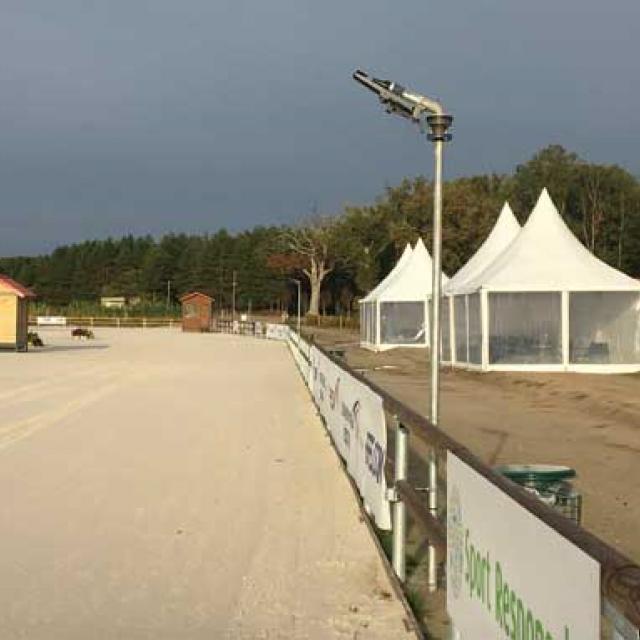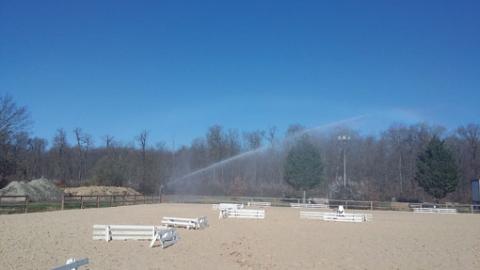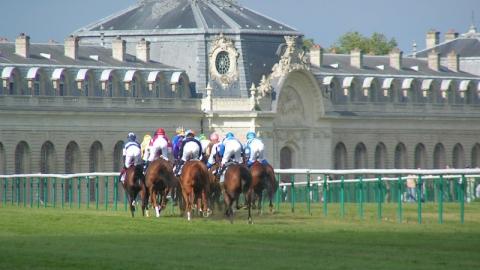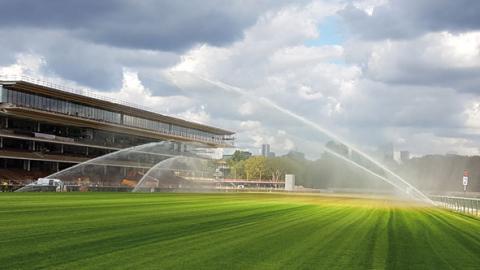The Mecca of the equestrian world, created by the clubs for the clubs, the Federal Equestrian Centre is the headquarters and administrative centre of the French Equestrian Federation (FEE).

What is the Federal Equestrian Centre?
With a surface area of 300 hectares, located in the heart of the Sologne region, the Centre has 520 boxes or stables, 25 hectares of race tracks, 25 hectares of cross-country courses, 20 hectares of car parking, more than 5,000 m2 of offices, two hotels, 3 restaurants, 15 meeting rooms… It is the busiest equestrian site nationally, receiving the highest number of horses and ponies each year.
Apart from housing the permanent offices of the FFE, the member clubs also organise their own courses there during all the school holidays. They come with their own riders, horses, ponies and instructors.
Furthermore, every year they organise competitions and sporting events, including three major championships: the Generali Open de France, le Festival complet and le grand tournoi. The centre organises 70 to 80 days of competitions each year. Every summer, the site is sold out for a period of a month and a half, during the Generali Open de France, when the championnat de France attracts 15,000 riders and 25,000 visitors.
The Centre has also diversified its activities to become more profitable. Over the last four years, the Game Fair, the largest French show for hunting and nature-lovers, has been taking place at the Federal Equestrian Centre. The hotel infrastructure also allows for business seminars to be organised.
The Federal Equestrian Centre hosts no less than 70 days of events, 120 days of courses, 60 days of training and 100 days of meetings.
Spray-gun sprinklers for the outdoor sand arenas
I travelled to the site on a beautiful October morning, in the company of Denis Lemarié, head of sales at Rain Bird. Mr. Pierre-Adrien Boucan, the site manager, welcomed us into the Federation’s offices. The three of us then climbed into a 4x4 to travel around the site.
The site has a total of 27 arenas, tracks and courses, which can host the three Olympic disciplines: Eventing, dressage and jumping, as well as the 8 top level disciplines (Show-jumping, carriage riding, vaulting...). Of the 27 riding areas, 15 outdoor sand arenas have to be irrigated.
Very soon, on the left, we could see a large outdoor sand arena and the grandstands. Mr. Boucan explained to us: “We are in the very heart of the equestrian centre, at the main show arena and just alongside, the No. 1 ring”.
However, we were most interested in the large outdoor sand arena located a little further on. This is a new arena created from scratch, the largest on the site (145 m x 200 m). The arena has undergone a significant change: railings and planks either side, with a 15 cm layer of Fontainebleau sand. The fine sands of Fontainebleau have a very small particle size (< 350 µm), with a high silicone content and round to sub-angular grains. Being very fine and pure, it is used on all of the site’s outdoor arenas.
The ground is watered because, so as not to damage the horses’ limbs, it must be soaked with water while remaining firm and pliable. Thus, we were able to observe around the arena 16 ultra-modern Rain Bird XLR24 spray guns, positioned at a height of 2 metres. Mr. Boucan commented: “I try to limit the use of the spray guns because they require a lot of maintenance”. And Mr. Lemarié added “The height is not ideal because water is lost through wind drift, but we have had to position them high up out of the way of the public. During the competitions, there are a lot of children present and they can damage the sprinklers”.
The sprinklers function separately, one by one, because they need a lot of pressure to operate. Mr. Boucan explained: “I only irrigate during the competitions, three or four times per night, about ten minutes per irrigation; it is really just a light sprinkling. From the 20 irrigation runs, at 60 m3/h, we can see what has been consumed. I stop irrig ting when it rains, of course”.
The system will be drained and winterised. According to Mr. Boucan: “In winter, the frost plays havoc with the pipes, so for that reason we protect the system against the frost. I open up the system in April and close it down in October.”
We then headed towards the borehole and the building that houses the Rain Bird ESP-LXD decoder-based programmer. This controller enables Mr. Boucan to irrigate the main outdoor arena and one small riding area, situated alongside it. He added: “I go to each borehole during my lunch break to programme the sprinklers.” In fact, he has not had a central control system installed on the site. However, the site at the present time has two Rain Bird controllers and two Irritrol controllers. Installing the central control system would enable Mr. Boucan to save time because he would be able to programme the sprinkling from his mobile phone or computer. Mr. Lemarié proposes a compromise solution, which would solve the problem, at least for the two Rain Bird controllers: “You could add a Logic Controller cartridge to the inside of each controller, in this small casing, and control the system remotely with your mobile”. This solution appeared to be of interest to Mr. Boucan.
A few metres away from the service room there is a borehole, sunk to a depth of 60 metres into the Beauce aquifer, which supplies the spray guns with water.
The water is clean so it does not have to be filtered. Mr. Boucan has only had to apply a few chemical treatments. The site has a total of five boreholes, which supply 15 sorting surfaces and they are connected to each other. Thus, if one borehole fails, the other boreholes take over. There is no lack of water but, according to Mr. Boucan: “It has to be put to good use”. The water pumped from the aquifer is also used to water the horses in the boxes or stables.
We climbed back into the 4x4 and headed towards another outside arena, a lot smaller, which Mr. Boucan wanted to show us. We passed alongside a very beautiful red brick building, which houses the castle’s old sheep pen, and then we arrived at the arena. It is slightly smaller than the first one and irrigated with 10 Rain Bird 3300 rain guns, an older model. Just behind it, an even smaller arena is irrigated with 4 spray guns of the same model. We then walked towards the equipment room, which houses the controller that allows the irrigation of the two arenas to be scheduled. This time, the controller is a multi-wired Rain Bird ESP-LXEM, which is less expensive than the ESP-LXD decoder-based controller, but it is quite sufficient for a small surface.
A brand-new indoor riding area
The last stage of our tour of the site took us to the brand new 4,000 m2 indoor riding area with a very high and spectacular wooden structure. It was delivered in July but Mr. Boucan has not used it yet. He hopes to use it in the winter and he has acquired two hose reels for its irrigation. Mr. Lemarié explained his choice of irrigation. “We are unable to use the spray guns in the riding area because, on the one hand, the surface area is too large and we would not be able to cover it completely; and we would also risk wetting the flooring and damage the wooden structure.” The site has three 4,000 m2 indoor arenas in total.
Just to the side of the riding area we were able to see the château, a beautiful old building in the process of restoration, which accommodates a restaurant, conference rooms and a hotel. A little surprised by all the work being carried out on the site, I asked Mr. Boucan about the funding. He replied: “This is entirely financed out of our own funds, i.e. the subscription fees and payments made to the Federation, not to mention the competitions and various events that we organise. We are the profit centre”.
The major fixtures: • 3 indoor riding arenas of 4,000 m2 • 10 adaptable show-jumping arenas • 1 equestrian field • 1 national cross-country course • 5 dressage rectangles • 9 horse-ball fields • 2 polo fields • 1 Havrincourt ring • 1 horse-training and lunging pen • 1 gallop track • 1 marathon carriage driving course • 520 permanent boxes or stables • 8 parking lots for horse boxes, trucks and vans • 3 restaurants capable of seating 300 people, • 15 meeting rooms, adapted and equipped • fully equipped service rooms, • 2 administrative buildings measuring over 5,000 m2 • 85 hotel rooms • 3 WC blocks.



